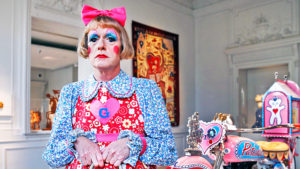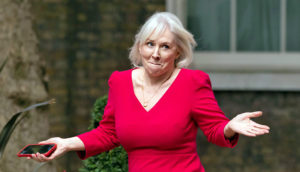Storm Eunice tore the Millennium Dome’s PTFE-coated fibreglass roof to shreds over the weekend. In the footage that circulated on social media, the steel struts that make up the underlying structure lie unnervingly exposed, like a whale carcass on the ocean floor.
Its innards are amusement infrastructure, geared to big-ticket events: Simply Red, Beyoncé, Strictly Come Dancing Live. But before this incarnation, it was a key battleground in a culture war that first took shape during the Second World War, erupted into factional conflict during the Thatcher years, and has since devolved into scattered, bitter insurgency: the contest over the proper relationship between artists and the state.
The Dome’s tattered corpse is a fitting symbol for a Britain scrabbling for public meaning, amid the wreckage of the cultural settlement that succeeded the last Gilded Age — a settlement now well and truly defunct. But two days after Storm Eunice flayed it came the news of a different structure, yet to be born: the first stately home to be built in England for over a century.
Taken together, the Dome’s death and this putative grand mansion tell the story both of Britain’s tragic experiment with artistic egalitarianism, and also of what came before and may yet succeed it.
In 1900, England’s richest 1% held some 75% of the country’s wealth. Among many other things, one effect of this disparity was that if you wanted money for the arts, you needed a rich patron. It was war that took the gilt off that age, in a grand conflagration of people and resources that decimated the old imperial aristocracy, even as it minted wealthy new wartime industrialists.
Two world wars also shredded the leisure — and a great deal of the wealth disparity — that shored up the old funding model for cultural life. Fearful for the nation’s artistic future, Britain’s wartime government founded CEMA, the Commission for the Encouragement of Music and the Arts. Bureaucracies, once created, are tenacious. CEMA was re-founded in 1946 by Royal Charter as the Arts Council — the body that would, five decades on, direct much of the funding for the Millennium Dome fiasco.
John Maynard Keynes, CEMA’s first chair, described its remit as “to encourage the best British national arts, everywhere, and to do it as far as possible by supporting others rather than by setting up state-run enterprises”. But it never quite worked like that. The Arts Council’s first notable success was, in fact, illustrative not of this principle but of the opposite: not a return to independent efflorescence of cultural life, but a new kind of state patronage modelled on wartime collectivism.
The body was responsible for the 1951 Festival of Britain, an event intended to mark the centenary of Prince Albert’s 1851 Great Exhibition. Albert’s event was self-financing, and made a profit. In contrast, the Festival of Britain was funded by the government, and aimed to showcase all that was “modern, forward-looking and contemporary” in British culture and design, including the concrete South Bank Centre. A public unified by wartime collectivism and eager for a brighter and less bomb-filled future were enthusiastic. It’s estimated that of a then-population of 49 million, around half participated in the nationwide Festival in some way: the high point of a Keynesian social-democratic merger of state largesse and elite cultural progressivism.
Winston Churchill reportedly hated it, describing it as “three-dimensional socialist propaganda”. As soon as he decently could, following his re-election in 1951, he had the Festival’s aluminium Skylon monument demolished and turned into ashtrays: presaging the culture war that was to follow.
By the Seventies, public-sector progressivism and accompanying state largesse had percolated from elite socialist bureaucrats to a broad-based creative class funded by subsidy, increasingly radical in the wake of the hippie revolution, and determined to smash convention everywhere from (subsidised) dramaturgy for children to prostitution-themed exhibitions at the (subsidised) Institute of Contemporary Art. Under Thatcher, the Tories grew ever keener to cut this antagonistic arts counter-elite down to size.
In 1985, Norman Tebbit complained that this publicly-funded arts ecosystem was full of elitism and (more to the point, from a Tory perspective) Left-wing political bias. But the Thatcherite cure for this taxpayer-funded enemy within addressed less the enmity than the funding. Francis Maude argued in 1985 that the postwar state-subsidy model needed to be dismantled, and what creatives needed was a return to the prewar “patronage” model. As this kind of wealth now accrued less to super-rich individuals than to corporations, that meant corporate sponsorship.
Budgets were cut, and innovations introduced to forge stronger links with business, all turbo-charged by another Tory innovation: the National Lottery. But these innovations failed to defang the progressive arts blob. For the Lottery instantly created a colossal pot of money earmarked for “good causes”, a development which in turn sprouted new cadres of (generally also progressive) arts bureaucrats tasked with dispensing it.
Paradoxically, then, the Thatcher-era attack on government-funded elitism and political bias had the opposite of the intended effect. It didn’t rein in Left-leaning political bias in the arts, or hack the cultural elite down to size. All it did was reduce direct government control over the sector, while entrenching mutual hostility between arts administrators and the Tory Party and pushing anything that showed the faintest glimmer of popular appeal out into the private sector.
Tory arts policy thus achieved less a business-driven return to conservative values in the arts than a selective reorienting of artistic radicalism. This new cultural order leaned ever harder into convention-smashing, even as it dialled class politics back to vague murmurs about the wickedness of capitalism and slapped sponsors’ logos on the flyers. So by the time Blair inherited it, the Arts Council was the perfect vehicle for the public ethos associated with his reign: progressive ideals inflected by commercial funding, aesthetics and priorities.
The man whom Thatcher called her “greatest achievement” continued the anti-elitist push begun by Maude and Tebbit, telescoping all cultural policy — high and low — into a single Department of Culture, Media and Sport. The cheerfully demotic and venal output of the resulting “creative industries” was to be marketed worldwide as “Cool Britannia”. Purportedly a bloom of new British cultural self-confidence, this in practice consisted mainly of strip-mining Britain’s cultural heritage for a content-agnostic, pro-profit anti-elitism powered by corporate “patronage”.
It’s some distance from the Arts Council’s postwar remit, but this was far from just Blair’s fault. (He didn’t even come up with the idea to build a dome.) It simply reveals the too-great paradox at the heart of state-funded art.
How are egalitarian, taxpayer-funded government bodies tasked with responsible spending and staffed by progressives meant to preserve and nurture a cultural legacy from the age of aristocratic patronage? The Dome itself encapsulated, at a budget overrun of £204m, the fruits of that paradox. “Body”, sponsored by Boots, Roche and L’Oréal; “National Identity”, sponsored by Marks & Spencer; “Our Town Story”, sponsored by McDonald’s.
Tony Blair described the project as “Britain’s opportunity to greet the world with a celebration that is so bold, so beautiful, so inspiring that it embodies at once the spirit of confidence and adventure in Britain and the spirit of the future in the world.” And it did indeed capture the contradictory nature of budget-conscious, government-subsidised “creativity”.
Start with the sponsorship deal; work backwards to what the content should be; and always, always, choose convention-smashing or corporate vacuity over anything that smacks of aristocracy. No wonder the contradictory radical and conservative impulses of state art have driven the contemporary Arts Councils to a widely mocked statement of content-free inclusivity, which envisions a Britain where all have “access to a remarkable range of high-quality cultural experiences” even as it rebrands artists as “creative practitioners” and relativises “high-quality” and “cultural” to meaninglessness.
Storm Eunice hardly needed to flay the Dome’s sunken carcass; the bones of our erstwhile high culture have long since been picked clean. That old high culture, though, was largely the product not of government subsidy but what Aristotle called “magnificence”: “a fitting expenditure involving largeness of scale”.
For Aristotle, it was a matter of honour for the wealthy to spend huge sums to ensure something “most beautiful and most becoming” rather than according to “how much it can be produced and how it can be produced most cheaply”. And much as the twentieth-century egalitarian in me rebels at the thought, most of what we call “heritage” today is a product of such “magnificence”: the stately homes, the sculptures, the ornamentation, orchestral music and so on.
There are many indications today that as we leave the long twentieth century, the world is returning to Gilded Age levels of economic inequality. There are many downsides to this; but it also signals our return to the kind of world in which a super-rich caste exists who can afford to be patrons on a “magnificent” scale.
Taxing the mega-rich mostly encourages them to hide their wealth elsewhere. But encouraging them to spend magnificently creates not just jobs but also beauty, as well as things that endure — such as the grand mansions and monumental architecture that form our “heritage” today.
Perhaps, then, if we are unable to prevent the re-emergence of this plutocracy, the question isn’t how to cut these giants down to size. Rather, it’s how to reorient them from the mendacious and niggardly “man-of-the-people” minimalism exemplified by the likes of Steve Jobs or Mark Zuckerberg, toward the kind of magnificence able to reverberate positively through the culture.
Consider the alternatives: that we either remain mired in the Millennium Dome model, in which public artworks serve largely as a conduit for woke capital or state propaganda; or else we simply abandon public culture, and the technologies which now stream personalised content to all our individual screens become the only things we share.
If we’re doomed to a new aristocracy, should we not at least demand that they are magnificent?
Disclaimer
Some of the posts we share are controversial and we do not necessarily agree with them in the whole extend. Sometimes we agree with the content or part of it but we do not agree with the narration or language. Nevertheless we find them somehow interesting, valuable and/or informative or we share them, because we strongly believe in freedom of speech, free press and journalism. We strongly encourage you to have a critical approach to all the content, do your own research and analysis to build your own opinion.
We would be glad to have your feedback.
Source: UnHerd Read the original article here: https://unherd.com






